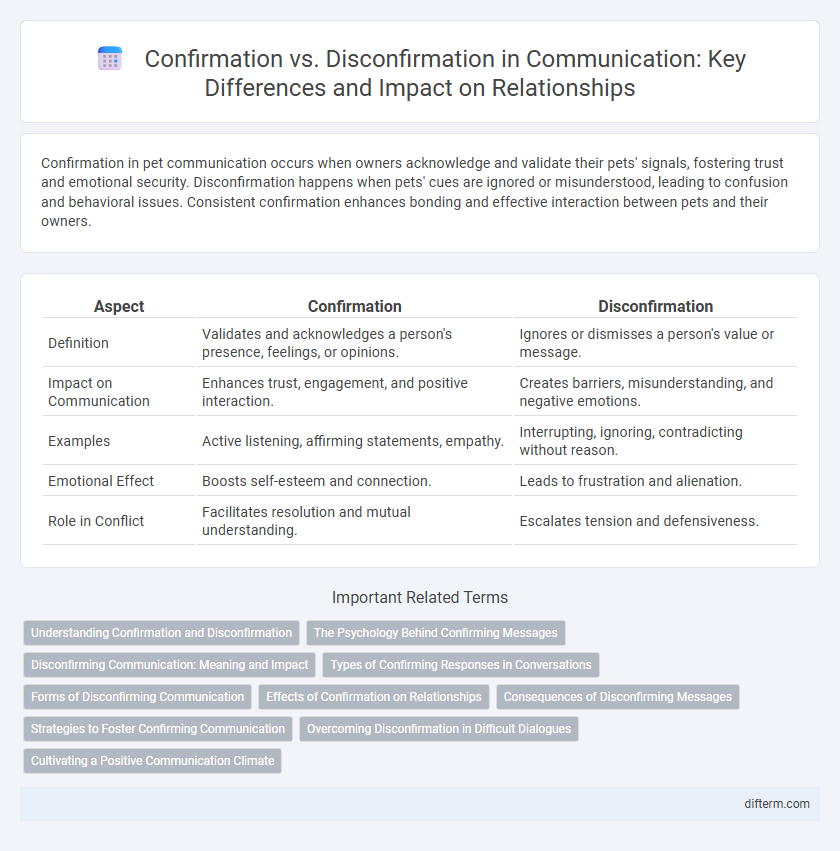Confirmation in pet communication occurs when owners acknowledge and validate their pets' signals, fostering trust and emotional security. Disconfirmation happens when pets' cues are ignored or misunderstood, leading to confusion and behavioral issues. Consistent confirmation enhances bonding and effective interaction between pets and their owners.
Table of Comparison
| Aspect | Confirmation | Disconfirmation |
|---|---|---|
| Definition | Validates and acknowledges a person's presence, feelings, or opinions. | Ignores or dismisses a person's value or message. |
| Impact on Communication | Enhances trust, engagement, and positive interaction. | Creates barriers, misunderstanding, and negative emotions. |
| Examples | Active listening, affirming statements, empathy. | Interrupting, ignoring, contradicting without reason. |
| Emotional Effect | Boosts self-esteem and connection. | Leads to frustration and alienation. |
| Role in Conflict | Facilitates resolution and mutual understanding. | Escalates tension and defensiveness. |
Understanding Confirmation and Disconfirmation
Understanding confirmation involves recognizing and validating another person's feelings, thoughts, or ideas, which reinforces positive communication and strengthens relationships. Disconfirmation, in contrast, occurs when a person's message is ignored, rejected, or invalidated, leading to feelings of exclusion and misunderstanding. Effective communication relies on confirmation to build trust and rapport, while disconfirmation can hinder empathetic connections and escalate conflicts.
The Psychology Behind Confirming Messages
Confirming messages validate a person's self-identity and foster positive communication by acknowledging their feelings, ideas, or experiences. These messages enhance psychological well-being by promoting trust, reducing anxiety, and encouraging openness in interpersonal relationships. Understanding the psychology behind confirming messages reveals their role in reinforcing self-esteem and creating supportive communication environments.
Disconfirming Communication: Meaning and Impact
Disconfirming communication occurs when one person's messages dismiss or ignore the other's presence or ideas, leading to feelings of rejection and invalidation. This type of interaction negatively impacts self-esteem and relational satisfaction, often causing conflict and emotional distance. Recognizing disconfirmation is crucial for improving communication dynamics and fostering healthier, more supportive relationships.
Types of Confirming Responses in Conversations
Confirming responses in conversations include recognition, acknowledging the other person's presence or existence; acknowledgment, showing that the speaker's message has been received and understood; and endorsement, expressing agreement or support for the speaker's ideas or feelings. These responses enhance communication effectiveness by validating the speaker's experience and fostering trust and openness. Types of confirming communication can be verbal, such as direct statements, or nonverbal, including eye contact and nodding.
Forms of Disconfirming Communication
Forms of disconfirming communication include impervious responses, where one party ignores or fails to acknowledge the other's message, and interrupting responses, which disrupt or cut off the speaker. Tangential responses shift the topic away, while impersonal responses use formal or dismissive language, undermining genuine connection. Ambiguous responses create confusion by sending mixed or unclear signals, all of which contribute to relational dissatisfaction and communication breakdown.
Effects of Confirmation on Relationships
Confirmation in communication fosters trust and strengthens emotional bonds by validating individuals' thoughts and feelings. This positive reinforcement encourages open dialogue, enhancing relational satisfaction and cooperation. Confirmed partners or colleagues exhibit greater empathy, commitment, and willingness to resolve conflicts constructively.
Consequences of Disconfirming Messages
Disconfirming messages can lead to feelings of rejection, decreased self-esteem, and emotional distress, significantly harming interpersonal relationships. These messages undermine individuals' sense of worth and belonging, causing resistance to further communication and increased relational tension. Persistent disconfirmation may result in withdrawal, reduced cooperation, and deterioration of trust between communicators.
Strategies to Foster Confirming Communication
Strategies to foster confirming communication include active listening, which validates the speaker's feelings and encourages openness. Using affirming language and nonverbal cues such as nodding and eye contact reinforces respect and understanding. Providing timely and specific feedback enhances clarity and strengthens interpersonal connections.
Overcoming Disconfirmation in Difficult Dialogues
Overcoming disconfirmation in difficult dialogues requires active listening, validating others' perspectives, and expressing empathy to rebuild trust and connection. Strategies such as reflective feedback and acknowledging emotions help reduce defensiveness and foster mutual understanding. Consistent, respectful communication creates an environment where confirmation becomes the norm, improving relationship outcomes.
Cultivating a Positive Communication Climate
Confirmation in communication involves recognizing and valuing others' thoughts and feelings, which fosters trust and openness. Disconfirmation, characterized by ignoring or rejecting messages, creates a hostile environment that undermines relationship development. Cultivating a positive communication climate relies on consistent verbal and nonverbal confirmation to promote mutual respect and collaboration.
confirmation vs disconfirmation Infographic

 difterm.com
difterm.com